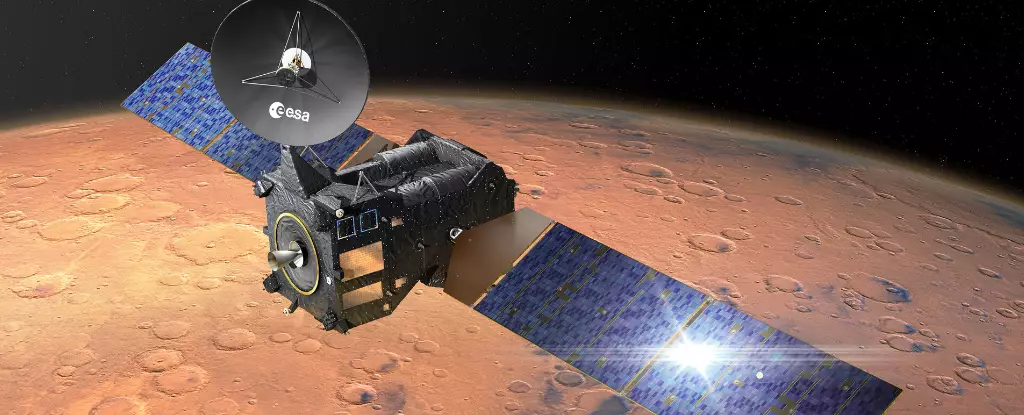

In a profound intertwining of art, science, and citizen engagement, the Exomars Trace Gas Orbiter (TGO) achieved a remarkable milestone in May 2023. Designed and operated by the European Space Agency (ESA), the TGO sent a radio signal to Earth to simulate an extraterrestrial communication. This event served as a central facet of the innovative project “A Sign in Space,” which not only aimed to broadcast a message from Mars but also invited individuals worldwide to participate in decoding it. The project’s inception was inspired by the imaginative narratives found in Cosmicomics, penned by the celebrated Italian author Italo Calvino. By melding literary inspiration with scientific inquiry, this initiative exemplifies how interdisciplinary collaboration can captivate public interest and involve them in the wonders of space exploration.
“A Sign in Space” represents a remarkable partnership between multiple esteemed organizations including the SETI Institute, Green Bank Observatory, and INAF, alongside the ESA. The mission was clear: engage citizen scientists in the process of deciphering the signal from Mars. Upon detection by three different radio astronomy observatories on Earth, the challenge transformed into a collective effort where over 5,000 individuals globally eagerly joined forces online. This unprecedented level of public participation marks a significant shift in how scientific challenges are approached and solved, highlighting the power of collaboration in the age of the Internet.
The project witnessed a year-long quest, filled with countless trials and errors, until it culminated in a triumphant breakthrough. Ken and Keli Chaffin, a father-daughter duo hailing from the United States, emerged as the unlikely heroes of this vast undertaking. Their persistence paid off when they successfully unraveled the message after rigorous simulations. The decoded information, symbolized through a series of clusters represented by white dots and lattices against a dark backdrop, hinted at the building blocks of life. Such findings invoke not only ecological interpretations but unlock profound philosophical questions about the existence of life beyond Earth.
At the heart of this transformative endeavor is Daniela de Paulis, a media artist and licensed radio operator who serves as the Artist in Residence at the SETI Institute and Green Bank Observatory. De Paulis conceptualized the project to blend media art with astrobiology, establishing a novel narrative about the potential for life in the cosmos. Through her collaboration with astronomers and computer scientists, she crafted the original message, merging her artistic vision with scientific rigor. The culmination of their efforts was a decoded image featuring five amino acids displayed in a unique, retro-inspired format, reflecting both the complexity and beauty of molecular structures crucial for life.
Keli and Ken Chaffin’s message included a detailed explanation of their decoding process, revealing the intricate techniques they employed using Margolus reversible cellular automata. This sophisticated understanding of algorithmic communication emphasizes the complexity of translating signals into comprehensible formats. Notably, their process incorporated a reversible computational model, showcasing a remarkable blend of scientific intuition and technical skill. The decoded representation employed graphical notations, enhancing its visibility and ease of understanding.
As the dust settles on the remarkable feat of extracting and interpreting the Martian message, de Paulis and her collaborators now embark on a new journey: understanding what the decoded information implies. The possibilities of interpretation span a vast spectrum, inviting many perspectives on the nature of the message. Is it a call for communication, a proposition of cultural exchange, or even a warning? Each interpretation could evoke distinct philosophical, ethical, and scientific discussions, inviting broader considerations of humanity’s place within the universe.
The project encourages ongoing public engagement through platforms like Discord, allowing participants to share independent analyses and theorize upon the implications of the decoded message. This openness does not merely democratize access to scientific processes; instead, it fosters a vibrant discourse on the meaning of potential extraterrestrial communication. Promoting a collaborative dialogue among participants, the project serves as a litmus test for readiness: Is humanity prepared to establish contact with an alien civilization?
In a world where scientific discovery increasingly gains momentum through social collaboration, projects like “A Sign in Space” exemplify how the convergence of art, science, and community can ignite imaginations and stir deep inquiries into our existence. By moving beyond traditional paradigms and engaging with global audiences, the project not only fosters a collective passion for space exploration but also poses timeless questions about life itself and our place in the cosmos. Indeed, as we decode the messages that the universe may hold, we may very well begin to decode our understanding of life on Earth.
Natural gas leaks are a growing concern in both urban and rural settings, with potential…
Recent groundbreaking research at the University of Vienna has unveiled a novel interplay of forces…
In recent years, perovskites have garnered significant attention in the fields of materials science and…
For decades, astronomers have probed the depths of the Milky Way, grappling with two perplexing…
Foreign direct investment (FDI) in developing nations has long been heralded as a path to…
As spring beckons in April and May, stargazers have the unique opportunity to witness nature's…
This website uses cookies.